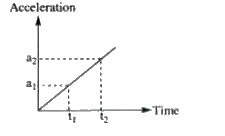A body of mass 5 kg has linear momentum of 20 kgm/s. If a constant force of 5N acts on it in the direction of its motion for 10s. The change in kinetic energy of the body is Solution in Telugu
320J
600J
200J
450J
The correct Answer is:D
Step by step video, text & image solution for A body of mass 5 kg has linear momentum of 20 kgm/s. If a constant force of 5N acts on it in the direction of its motion for 10s. The change in kinetic energy of the body is by Physics experts to help you in doubts & scoring excellent marks in Class 11 exams.
Topper's Solved these Questions
- BOOK - AAKASH SERIESCHAPTER - WORK -POWER-ENERGYEXERCISE - LECTURE SHEET (EXERCISE -III CONSERVATIVE AND NON CONSERVATIVE FORCES STRAIGHT OBJECTIVE TYPE QUESTIONS)13videos
WORK -POWER-ENERGY
- BOOK - AAKASH SERIESCHAPTER - WORK -POWER-ENERGYEXERCISE - LECTURE SHEET (EXERCISE -III CONSERVATIVE AND NON CONSERVATIVE FORCES INTEGER TYPE QUESTIONS)1videos
WORK -POWER-ENERGY
- BOOK - AAKASH SERIESCHAPTER - WORK -POWER-ENERGYEXERCISE - LECTURE SHEET (EXERCISE-I WORKDONE BY FORCE INTEGER TYPE QUESTIONS)1videos
WORK -POWER-ENERGY
- BOOK - AAKASH SERIESCHAPTER - VISCOSITY EXERCISE - Questions for Descriptive Answers3videos
VISCOSITY
- BOOK - AAKASH SERIESCHAPTER - WORK POWER ENERGYEXERCISE - EXERCISE - 361videos
WORK POWER ENERGY
Similar Questions
The work done in carrying a body from A to B is 20 J and from B to C is 15J. The work done in moving the body from A to C assuming the force involved in all the cases is conservative force is
02:01View SolutionA block of mass 2kg is moving with speed v0 towards a massles sunstretched spring (K=10N/m). It is found that for maximum speed v0=√6.4m/s, the block compresses the spring, stops at that position and does not return back. Friction coefficient at surface is μ=1x. Value of x is
02:05View SolutionAcceleration time graph of a particle is shown. Workdone by all the force acting on the particle of mass m in time interval t1 and t2, while a1 and a2 is the acceleration at time t1 and t2. Then find the value of a1 is ma21m21[t42−t41]. Then the value of n is
 03:23View Solution
03:23View SolutionAn iron sphere of mass 20×10−3 kg falls through a viscous liquid with terminal velocity 0.5 m/sec. Find the terminal velocity of another iron sphere of mass 54×10−2 kg.
01:21View SolutionIf →A+→B=→Rand2→A+→B is perpendicular to →B then
01:09View SolutionA constant force acting on a body of mass 5kg change its speed from 5ms−1 in 10s without changing the direction of motion. The force acting on the body is
04:28View SolutionCalculate the force acting on a body whose linear momentum changes by 20 kg ms(-1) in 10 s.
03:36View SolutionA body of mass 5 kg is moving with a momentum of 10 kg m//s . A force of 0.2 N acts on it in the direction of motion of the body for 10 sec. The increase in its kinetic energy.
06:28View SolutionA force of 10 Newton acts on a body of mass 20 kg for 10 seconds. Change in its momentum is
06:28View SolutionA constant force acting on a body of mass of 5 kg change its speed from 5ms^(-1) "to" 10ms^(-1) in 10 s without changing the direction of motion. The force acting on the body is
01:33View SolutionA body of mass 4 kg is moving with momentum of 8kgms−1. A force of 0.2 N acts on it in the direction of motion of the body for 10 s. The increase in kinetic energy is
05:11View SolutionThe momentum of a body of mass 8 kg is 20 kg m/s. A force of 12 N acts on the body in the direction of motion for 4 s, the increase in the kinetic energy is
03:23View SolutionA body of mass 5kg has linear momentum of 20 kgm/s. If a constant force of 5N acts on its in the direction of its motion for 10 s. The change in kinetic energy of the body is
View SolutionA body of mass 5 kg has linear momentum of 20 kgm/s. If a constant force of 5N acts on it in the direction of its motion for 10s. The change in kinetic energy of the body is
View SolutionA constant force acting on a body of mass of 5 kg change its speed from 5ms^(-1) "to" 10ms^(-1) in 10 s without changing the direction of motion. The force acting on the body is
View Solution

